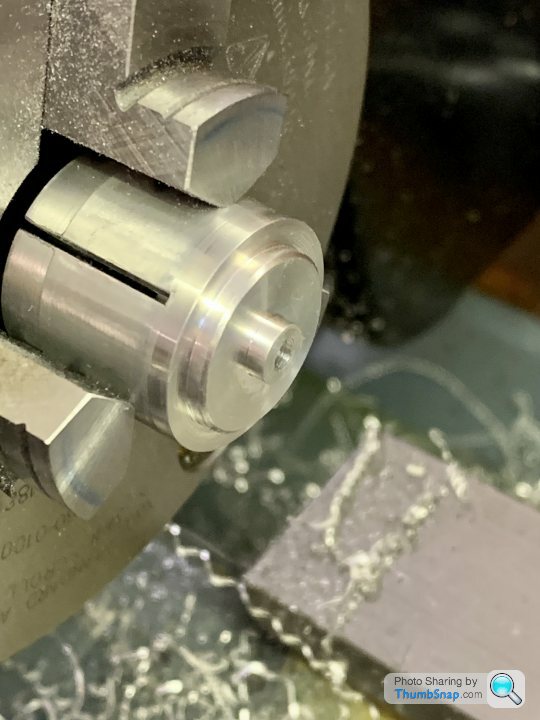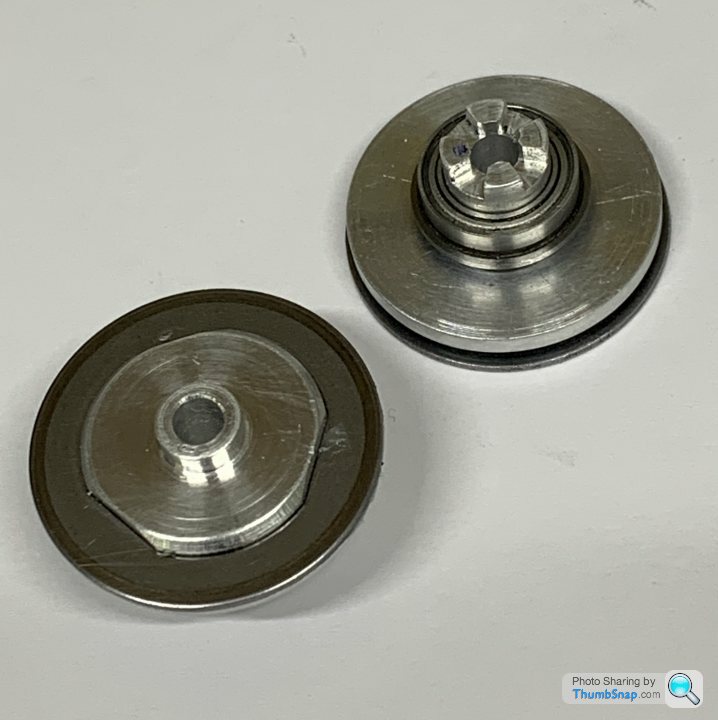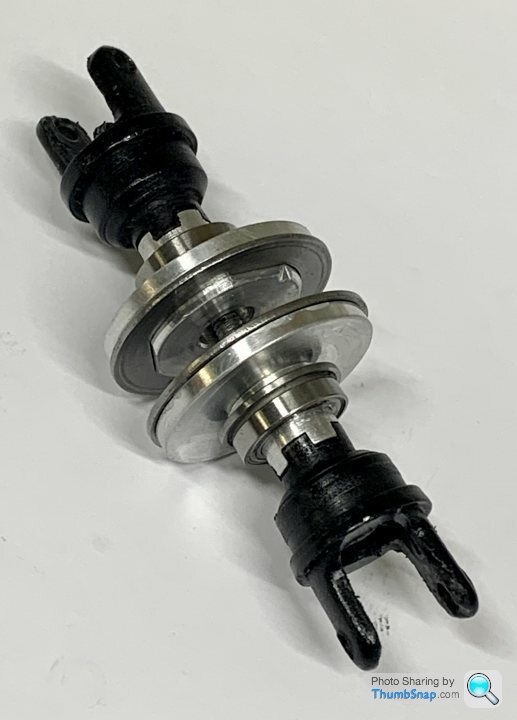Workholding Problem
| Dr_GMJN | 11/09/2021 20:24:07 |
1602 forum posts | This is related to this thread on making tapered castellations on an R/C car differential component Making Tapered Castellations in Aluminium | Model Engineer (model-engineer.co.uk) |
| Jager | 11/09/2021 20:59:50 |
| 44 forum posts 5 photos | I may well be misunderstanding the problem. If it is the length of the large diameter shown in the chuck you need to reduce could you machine a ring, close fitting on the castellated section and superglue it on. Hold this in the chuck to machine large diameter and its length. When done just apply a litte heat to seperate. |
| Dr_GMJN | 11/09/2021 21:11:00 |
1602 forum posts | Posted by Jager on 11/09/2021 20:59:50:
I may well be misunderstanding the problem. If it is the length of the large diameter shown in the chuck you need to reduce could you machine a ring, close fitting on the castellated section and superglue it on. Hold this in the chuck to machine large diameter and its length. When done just apply a litte heat to seperate. Yes, basically I’m left with a small spigot to machine down a large boss, either on the lathe or the mill (both have chucks) and the spigot isn’t really big enough to hold the size to be machined. If a machined (split?) ring fits to the small spigot, isn’t that effectively the same as a chuck, or collet? Ultimately it’s the same bearing area? Edited By Dr_GMJN on 11/09/2021 21:13:47 |
| HOWARDT | 11/09/2021 21:24:39 |
| 1081 forum posts 39 photos | Machine the thin large diameter to a known size and clamp it into a shallow pot on the rotary table, then create the drive dogs. Doing it this way you can turn your diameters in one setup for concentricity then clock on the table if looking for better accuracy of slot position. |
| Henry Brown | 11/09/2021 21:54:11 |
618 forum posts 122 photos | If you have a four sided Stevenson collet block you could set it up in a four jaw on the lathe and use a suitably sized collet to hold the small diameter. Very useful bits of kit if you use ER32 collets on the mill... |
| Dr_GMJN | 11/09/2021 23:18:32 |
1602 forum posts | Henry, Howard, Thanks both. I don’t have a collet block, and ideally I don’t want to re-make the castellated bits. One of the issues is I can’t seat the large face against the chuck jaws because of a small bearing abutment. I suppose I could turn something to a fit on the bearing spigot, face it, then counterbore a clearance hole that the abutment would fit into. Then I could split it and use in both the lathe and R/T chucks? A bit like Jager’s superglue method but with a split rather than glue? Its from a ball differential, so absolute concentricity of the lobed washers and bearings isn’t essential (hopefully), since the balls will just roll over any slight error. ‘Swash’, or the washer faces not being normal to the bearing axis, would be much more of an issue. |
| Paul Kemp | 12/09/2021 01:53:13 |
| 798 forum posts 27 photos | I must be missing something? Assuming the 3 jaw or collet on the lathe runs reasonably true if you hold it on the castellated spigot I don't see why there is significant run out? As the large boss to be machined down is also oversize I would just hold it on the small spigot and machine the rest, then it must be true to the small spigot. There are many instances where large diameter parts especially castings are machined by holding on small chucking spigots so I don't see a problem. If you are worried take light cuts. If you really want belt and braces put a small centre drilling in the face, reduce the large part leaving a small projection with the centre in and last op remove the tailstock and machine off the small remaining spigot. I think you may be overthinking / worrying too much. If it helps the casting (cast iron) for the smokebox door on my traction engine which is 11" diameter was machined holding it on the 1 1/4" chucking spigot with no drama! Paul. |
| JasonB | 12/09/2021 07:16:12 |
25215 forum posts 3105 photos 1 articles | That was my thought to, just hold by the smaller diameter. had I been doing it I would have machined to the 3mm thickness first on the lathe and then done the milling. You should still be able to hold it by 2mm in the 3-jaw chuck, use a couple of parallels to space it off the chuck face when tightening but REMOVE before turning. Sawing off most of the waste won't be a bad thing either as the closer your turned cuts are to the chuck the less likely the work is to get pulled out. The other option is soft jaws which will easily hold that larger dia by just 1mm length leaving you plenty of clearance for machining down to 3mm
If you are really worried about the 3mm thickness varying then turn both sides of the flange,the spigot at one setting and washer side down to the washers ID all in one setting then saw/part off that way all diameters are concentric and true. Skim the sawn/parted face by holding the spigot. |
| Martin Connelly | 12/09/2021 08:18:22 |
2549 forum posts 235 photos | Have a look at this previous thread for ideas Advise to turn a thin router guide bush adapter Martin C |
| John Baron | 12/09/2021 08:27:35 |
520 forum posts 194 photos | Dr_GMJN, Mount the part on an expanding mandrel ! I've done this many times ! Turn a mandrel the right diameter and a good fit in the workpiece bore. Slit it at the free end first. Then use a small wood screw or other tapered screw to expand a slit in the end once the piece is on. A blind bore is more difficult and really needs a collet chuck to make the mandrel ! The same principle applies but you have to be able to expand the mandrel from the chuck end, which means drilling right through and using a pull rod to expand a taper.
Edit: Spelling. Edited By John Baron on 12/09/2021 08:30:04 |
| Dave S | 12/09/2021 09:21:45 |
| 433 forum posts 95 photos | Soft jaws are how I would do that. bore them to hold the larger diameter x2 mm deep. plenty of grip as they should match the curve perfectly, and repeatable setup ( I assume you have at least 4 to do) Dave |
| Tony Pratt 1 | 12/09/2021 09:44:34 |
| 2319 forum posts 13 photos | Hold in soft jaws if you have them or make a split bush to hold the castellated portion. The excellent Joe Pieczynski has a YouTube video on how to make the bush. Tony |
| Dr_GMJN | 12/09/2021 10:10:51 |
1602 forum posts | Ok thanks all. Martin - your link doesn’t work. I don’t have soft jaws. John: The central hole was drilled, so I guess may not be totally concentric to the turned features. It’s also tiny, so making an expanding mandrel that creates enough force to hold it would be a bit sketchy I think? Re. holding with the small spigot: The part is aluminium, and I’m worried about damaging the surface in chuck jaws, since it has to be a good fit on the bearing. Holding it by the O/D would be good, but I’d be gripping with the chuck on the last 2 mm or so - I thought this was bad practice in terms of chucks aren’t designed to grip like that. I read somewhere the jaws can spring slightly making the grip area even smaller, plus it doesn’t do the chuck much good?
|
| Tony Pratt 1 | 12/09/2021 11:25:58 |
| 2319 forum posts 13 photos | You either buy soft jaws, or use an Aluminium split bush on the small diameter or a stepped split bush on the O/D. Oh by the way you are right if you hold on 2mm of the O/D a scrap part is the likely end result & again holding on the small diameter with the chuck alone will mark the part for sure. Tony Edited By Tony Pratt 1 on 12/09/2021 11:28:49 |
| Paul Kemp | 12/09/2021 11:46:04 |
| 798 forum posts 27 photos | OP said he had a collet chuck, if that marks the smaller diameter it's not much cop. If the large diameter has run out when held in a collet either the collets are rubbish or the small and large diameters are not concentric anyway? Paul. |
| Martin Connelly | 12/09/2021 12:39:25 |
2549 forum posts 235 photos | Don't know what happened to the original link Advise to turn a thin guide bush adaptor Martin C |
| Zan | 12/09/2021 14:07:04 |
| 356 forum posts 25 photos | Soft jaws! Soft jaws and I repeat again! Or rough turn a top hat bush and slit it lengthwise a with a 1/16 saw. Fill cut with brass strip, Mount in Chuck carefully matking the position of jaw 1 bore to fit the castellated spigot remove brass strip refit to marked jaw and forget your problems this method will give far more accurate results than er chucks top hat bush needed for axial location. Perhaps long winded, but it will give the sort of results you cherish Edited By Zan on 12/09/2021 14:07:41 |
| bricky | 12/09/2021 18:50:45 |
| 627 forum posts 72 photos | I would use a wooden dowell or a piece of brush shaft glued onto the item to be machined with gorilla glue, the foaming type and clamped in the vice overnight.You would have to drill a hole in the dowell to incorporate the spigate. Next day set up in the four jaw and machine.When finished I would saw the wood off close to the steel but in this case you would have to split it off and using an old wood chisel to shave of the adhesive.I learned this from an article by Brian Wood . Frank |
| Dr_GMJN | 12/09/2021 19:21:54 |
1602 forum posts | The collets are fine, the issue is that the diameter is small, and so is the length to hold. The bearing abutments make it worse since there’s virtually no face-to-face contact to help take any axial machining loads. Same with using a chuck. In the end I made an aluminium split bush, counterbored to clear the bearing abutments:
|
| Mick B1 | 12/09/2021 19:51:54 |
| 2444 forum posts 139 photos | Posted by Zan on 12/09/2021 14:07:04:
Soft jaws! Soft jaws and I repeat again! .... Edited By Zan on 12/09/2021 14:07:41 Yes! Buy some! You'll never regret it. |
Please login to post a reply.
Want the latest issue of Model Engineer or Model Engineers' Workshop? Use our magazine locator links to find your nearest stockist!
Sign up to our newsletter and get a free digital issue.
You can unsubscribe at anytime. View our privacy policy at www.mortons.co.uk/privacy
- *Oct 2023: FORUM MIGRATION TIMELINE*
05/10/2023 07:57:11 - Making ER11 collet chuck
05/10/2023 07:56:24 - What did you do today? 2023
05/10/2023 07:25:01 - Orrery
05/10/2023 06:00:41 - Wera hand-tools
05/10/2023 05:47:07 - New member
05/10/2023 04:40:11 - Problems with external pot on at1 vfd
05/10/2023 00:06:32 - Drain plug
04/10/2023 23:36:17 - digi phase converter for 10 machines.....
04/10/2023 23:13:48 - Winter Storage Of Locomotives
04/10/2023 21:02:11 - More Latest Posts...
- View All Topics
- Reeves** - Rebuilt Royal Scot by Martin Evans
by John Broughton
£300.00 - BRITANNIA 5" GAUGE James Perrier
by Jon Seabright 1
£2,500.00 - Drill Grinder - for restoration
by Nigel Graham 2
£0.00 - WARCO WM18 MILLING MACHINE
by Alex Chudley
£1,200.00 - MYFORD SUPER 7 LATHE
by Alex Chudley
£2,000.00 - More "For Sale" Ads...
- D1-3 backplate
by Michael Horley
Price Not Specified - fixed steady for a Colchester bantam mark1 800
by George Jervis
Price Not Specified - lbsc pansy
by JACK SIDEBOTHAM
Price Not Specified - Pratt Burnerd multifit chuck key.
by Tim Riome
Price Not Specified - BANDSAW BLADE WELDER
by HUGH
Price Not Specified - More "Wanted" Ads...
Do you want to contact the Model Engineer and Model Engineers' Workshop team?
You can contact us by phone, mail or email about the magazines including becoming a contributor, submitting reader's letters or making queries about articles. You can also get in touch about this website, advertising or other general issues.
Click THIS LINK for full contact details.
For subscription issues please see THIS LINK.
Model Engineer Magazine
- Percival Marshall
- M.E. History
- LittleLEC
- M.E. Clock
ME Workshop
- An Adcock
- & Shipley
- Horizontal
- Mill
Subscribe Now
- Great savings
- Delivered to your door
Pre-order your copy!
- Delivered to your doorstep!
- Free UK delivery!






















 Register
Register Log-in
Log-in


